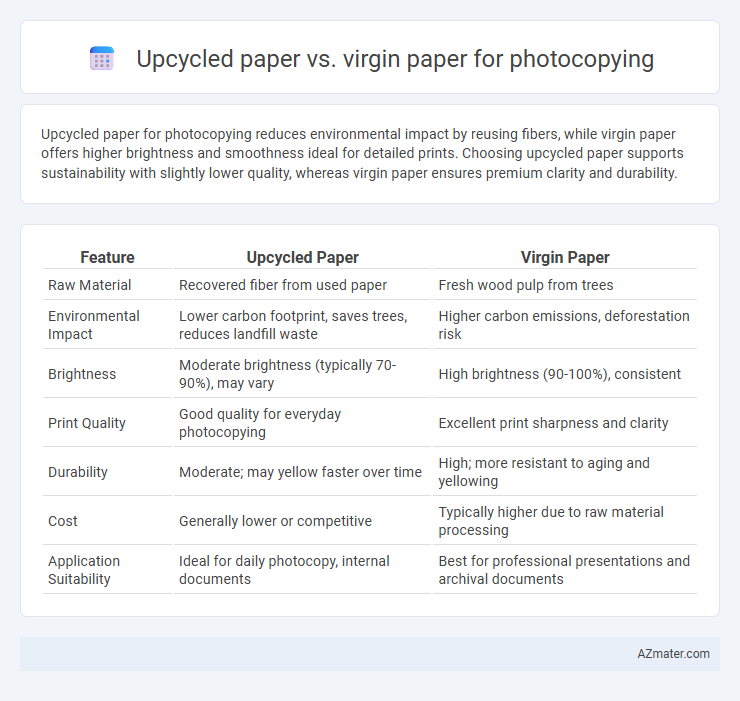Upcycled paper for photocopying reduces environmental impact by reusing fibers, while virgin paper offers higher brightness and smoothness ideal for detailed prints. Choosing upcycled paper supports sustainability with slightly lower quality, whereas virgin paper ensures premium clarity and durability.
Table of Comparison
| Feature | Upcycled Paper | Virgin Paper |
|---|---|---|
| Raw Material | Recovered fiber from used paper | Fresh wood pulp from trees |
| Environmental Impact | Lower carbon footprint, saves trees, reduces landfill waste | Higher carbon emissions, deforestation risk |
| Brightness | Moderate brightness (typically 70-90%), may vary | High brightness (90-100%), consistent |
| Print Quality | Good quality for everyday photocopying | Excellent print sharpness and clarity |
| Durability | Moderate; may yellow faster over time | High; more resistant to aging and yellowing |
| Cost | Generally lower or competitive | Typically higher due to raw material processing |
| Application Suitability | Ideal for daily photocopy, internal documents | Best for professional presentations and archival documents |
Introduction to Upcycled and Virgin Paper
Upcycled paper for photocopying is created by reprocessing used paper materials, reducing waste and conserving natural resources compared to virgin paper, which is produced directly from freshly cut trees. Virgin paper offers a smoother texture and higher brightness, often preferred for professional documents requiring sharp print quality. The choice between upcycled and virgin paper impacts environmental sustainability and print performance, making it essential to balance quality needs with ecological considerations.
Environmental Impact of Upcycled Paper
Upcycled paper for photocopying significantly reduces environmental impact by minimizing deforestation and conserving water compared to virgin paper production. It lowers energy consumption and reduces landfill waste through the reuse of post-consumer fibers, contributing to decreased carbon emissions. This sustainable choice supports circular economy principles, promoting resource efficiency and reducing pollution associated with traditional paper manufacturing processes.
Environmental Footprint of Virgin Paper
Virgin paper production for photocopying significantly increases the environmental footprint due to high energy consumption, water usage, and deforestation associated with sourcing raw wood fibers. This process leads to greater greenhouse gas emissions and contributes to habitat destruction compared to upcycled paper, which minimizes waste by reusing existing fibers. Choosing upcycled paper reduces the demand for fresh natural resources, lowering overall ecological impact and promoting sustainable office practices.
Differences in Manufacturing Processes
Upcycled paper for photocopying is produced by reprocessing waste paper, involving cleaning, de-inking, and reforming fibers to create new sheets, reducing raw material consumption and energy usage. Virgin paper manufacturing uses fresh wood pulp derived directly from logging, undergoing pulping and bleaching processes that often consume more water, chemicals, and energy. The upcycled paper process emphasizes sustainability and resource efficiency, whereas virgin paper manufacturing focuses on purity and consistent fiber quality for optimal print clarity.
Quality Comparison: Upcycled vs Virgin Paper
Virgin paper offers superior brightness and consistent texture, resulting in sharper print quality and smoother toner adhesion for photocopying. Upcycled paper, while environmentally friendly, may exhibit more fiber inconsistencies and lower brightness, potentially causing less vibrant copies and occasional toner smudging. Choosing virgin paper ensures optimal clarity and longevity for important photocopies, whereas upcycled variants prioritize sustainability with modest trade-offs in print quality.
Cost Analysis in Photocopying
Upcycled paper significantly reduces photocopying costs by utilizing reclaimed fibers, lowering raw material expenses compared to virgin paper. Virgin paper involves higher production costs due to the processing of fresh wood pulp, increasing the overall price per sheet in photocopying tasks. Cost efficiency in photocopying favors upcycled paper, offering businesses substantial savings while maintaining acceptable print quality.
Effects on Photocopy Machine Longevity
Upcycled paper often contains more impurities and uneven fibers compared to virgin paper, which can lead to increased wear and tear on photocopy machine components such as rollers and drum units. Virgin paper's consistent texture and higher quality reduce the risk of paper jams and mechanical strain, enhancing photocopier longevity. Using virgin paper typically results in fewer maintenance issues, extending the operational life of photocopy machines.
Print Clarity and Paper Texture
Upcycled paper for photocopy often has a coarser texture that can slightly reduce print clarity compared to virgin paper, which offers a smoother surface, enhancing sharpness and detail in prints. Virgin paper's consistent fiber quality results in fewer imperfections, providing crisp text and images ideal for professional documents. In contrast, upcycled paper's fibrous composition may cause minor ink absorption inconsistencies, affecting overall print quality but promoting environmental sustainability.
Availability and Market Trends
Upcycled paper for photocopying is increasingly available as sustainability drives demand in office supplies, with manufacturers expanding production to meet eco-conscious consumers. Virgin paper remains widely dominant in the market due to longstanding supply chains and consistent quality, but its share is gradually declining as businesses prioritize environmental impact. Market trends indicate a growing preference for recycled materials, prompting innovation and greater accessibility of upcycled paper products in various regional markets.
Choosing the Right Paper for Sustainability
Upcycled paper, made from recycled fibers, reduces deforestation and lowers carbon emissions compared to virgin paper produced from fresh wood pulp. Choosing upcycled paper for photocopying helps conserve natural resources and supports circular economy principles by minimizing landfill waste. High-quality upcycled paper often matches the brightness and durability of virgin paper, making it a sustainable yet practical choice for office environments focused on eco-friendly procurement.

Infographic: Upcycled paper vs Virgin paper for Photocopy
 azmater.com
azmater.com